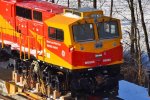Expect 34 FOBs, 85 escalators on Western Railway line in 2019
In order to cater to 36 lakh commuters, Western Railway has decided to construct 34-foot over-bridges, 85 escalators and 59 lifts that are likely to come up on Churchgate -Virar suburban railway corridor in 2019.
On Sunday, newly appointed Western Railway Divisional Railway Manager (DRM) Sunil Kumar Sag announced that he will fast-track all projects related to passenger amenities, including construction of wider foot over-bridges (FOBs), escalators, lifts, and other facilities at suburban stations in 2019.
Sag said that they will also ensure faster ticket booking experience at all stations and speedy dispersal of commuters from station areas. All access routes to stations will be clear of encroachments, he further added.
Along with this, WR has announced that it has started 25 exclusive counters to issue season tickets at 22 stations and 13 special UTS windows for women, senior citizens and the disabled at 11 stations.
Expect 34 FOBs, 85 escalators on Western Railway line in 2019
In order to cater to 36 lakh commuters, Western Railway has decided to construct 34-foot over-bridges, 85 escalators and 59 lifts that are likely to come up on Churchgate -Virar suburban railway corridor in 2019.
On Sunday, newly appointed Western Railway Divisional Railway Manager (DRM) Sunil Kumar Sag announced that he will fast-track all projects related to passenger amenities, including construction of wider foot over-bridges (FOBs), escalators, lifts, and other facilities at suburban stations in 2019.
Sag said that they will also ensure faster ticket booking experience at all stations and speedy dispersal of commuters from station areas. All access routes to stations will be clear of encroachments, he further added.
Along with this, WR has announced that it has started 25 exclusive counters to issue season tickets at 22 stations and 13 special UTS windows for women, senior citizens and the disabled at 11 stations.
Expect 34 FOBs, 85 escalators on Western Railway line in 2019




















